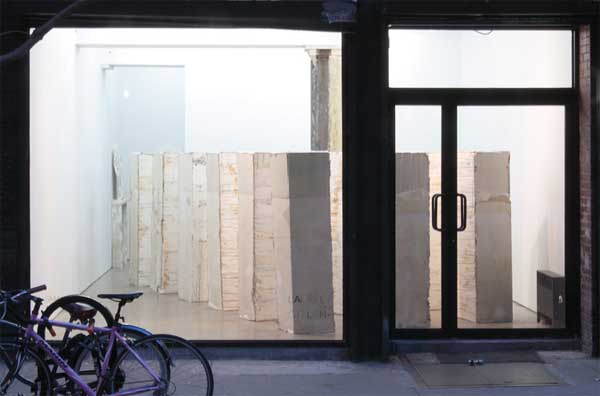
Allyson Vieira If I was a…but then again, no (1-18), 2010. Installation view via Laurel Gitlen
Allyson Vieira, Ozymandias
Laurel Gitlen, 261 Broome Street, New York
On view through this Sunday
The British Museum and the Louvre were newly minted, public institutions when a colossal hunk of granite portraying Ramesses II, one of the Egyptian Empire’s last great Pharaohs, arrived in London in 1816. During the early 19th century, museums and museology embodied the most ruthless characteristics of global expansion: insatiable greed and rampant consumption, unencumbered by taste or distinction. British and French militaries were deployed as art-handlers under the direction of archeologists and historians who themselves played curator, arranging countless acquisitions-by-murder in Egypt, Greece, and elsewhere. With new visibility, treasures such as the Elgin Marbles, stripped from the Parthenon, led to an explosion in art production. It is on these grounds that Ozymandias, Allyson Vieira’s first solo exhibition at Laurel Gitlen, finds its weight.
The centerpiece of Ozymandias—the ancient Greek name for Ramesses II—is If I was a…but then again, a six-ton, set of eighteen white slabs, each humanly scaled and evenly distributed throughout the main gallery. Vieira’s work invites quick assumptions about its rough-hewn construction. Passing through this formerly unified mass allows the viewer a closer inspection of each monolith’s variously poured, sawed, and incised surfaces, a record of their own making. Here, a mixture of concrete, plaster, and drywall, marked with drill holes and oxide stains, seems not too distant from striated marble, or an urban-Earthwork built from the scrap of a downtown construction site. The beginnings of a new form or the remnants of one fallen? By tracking in dirt from countless, well-rehearsed eras, If I was a… side-steps any neat categorization: freed from Ramesses’s idealized features as well as those of modernism, and, more specifically, the oppressive history of Minimalism. Vieira’s work is equally at home with the crumbling mud-figures of Thomas Houseago and Huma Bhaba, as well as the hard-edged, plaster dancers by Jennifer Cohen. Like these contemporaries, Vieira puts muscle into excavating previously conquered cultural terrain, combining rich materiality, figuration and hardware-store craft to prove the existence of unexplored art-historical territory. In the rear gallery, twin bas-reliefs pose questions of originality and technique in half-time with their grand counterpart out front. Between them, a live octopus, entitled Destroyer of Empire reminds us that mythology is the close cousin of any well-researched antiquity—art, or otherwise. The unique accomplishment of Vieira’s exhibition is the privileged point of access it offers the viewer: one that ricochets between centuries, from the fall of one empire to another and another; historical anomalies to suggest an incomplete oeuvre.
]]>